| Article ID | Journal | Published Year | Pages | File Type |
|---|---|---|---|---|
| 6699503 | Building and Environment | 2016 | 9 Pages |
Abstract
Previous adaptive thermal comfort research mainly emphasized the correlations between outdoor climate and thermal adaptation. In this paper, we explore the influence of indoor thermal experience on occupants' thermal adaptation, especially with regard to physiological adaptation. We also investigate whether people with distinct cold indoor exposures have different levels of physiological adaptation to cold environment. A comparative experiment, including both physiological measurements and subjective questionnaires, was conducted in China where winter indoor climates in the northern region (with pervasive district heating) are much warmer than the southern region (without district heating). Two subject groups were recruited, namely: (a) N-N group - subjects who had lived in the northern China with district heating all their life, and (b) S-N group - subjects who grew up in the southern region without district heating but recently moved to the north. The results indicate that S-N subjects who had lived their entire lives in cold wintertime indoor climates had slither physiological response and felt less uncomfortable in mild cold exposures than N-N subjects who lived in neutral-to-warm wintertime indoor climates. The findings suggest that indoor thermal exposures can also influence occupants' thermal adaptation, which can reserve as a reference to the future adaptive thermal comfort model.
Related Topics
Physical Sciences and Engineering
Energy
Renewable Energy, Sustainability and the Environment
Authors
Maohui Luo, Wenjie Ji, Bin Cao, Qin Ouyang, Yingxin Zhu,
